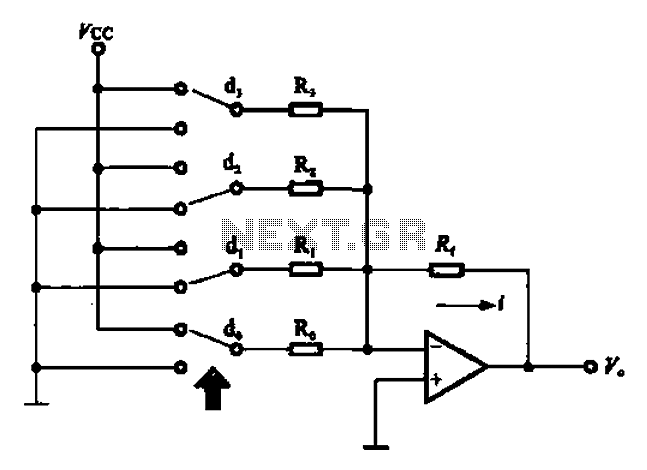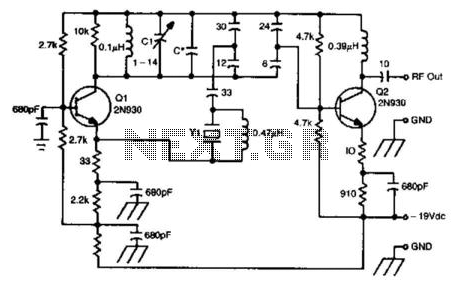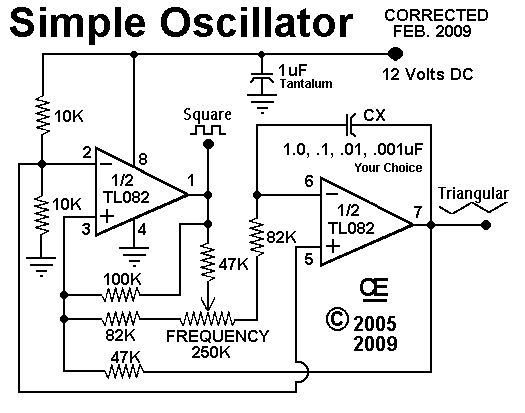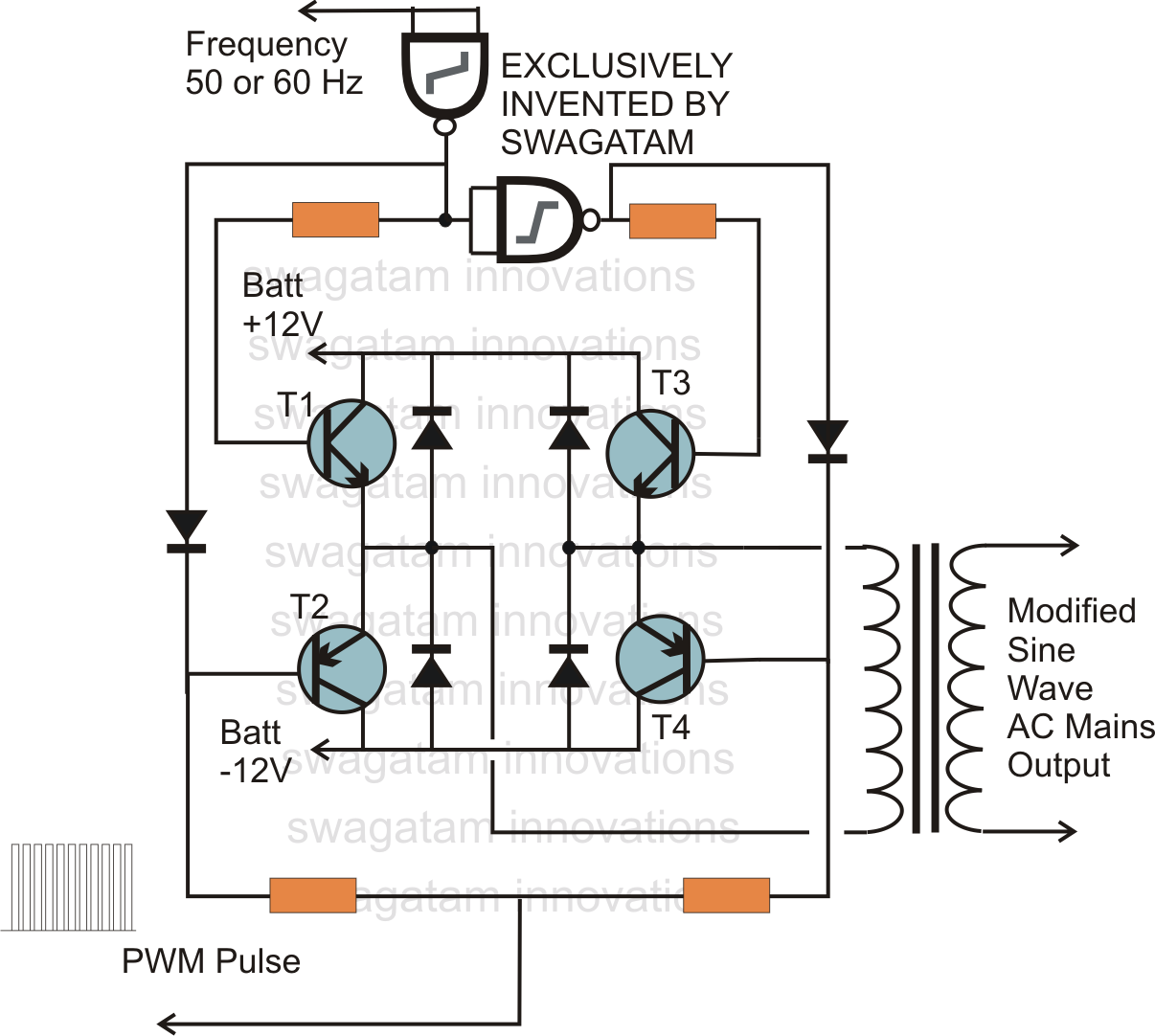
Oscillator Design Guide Structure
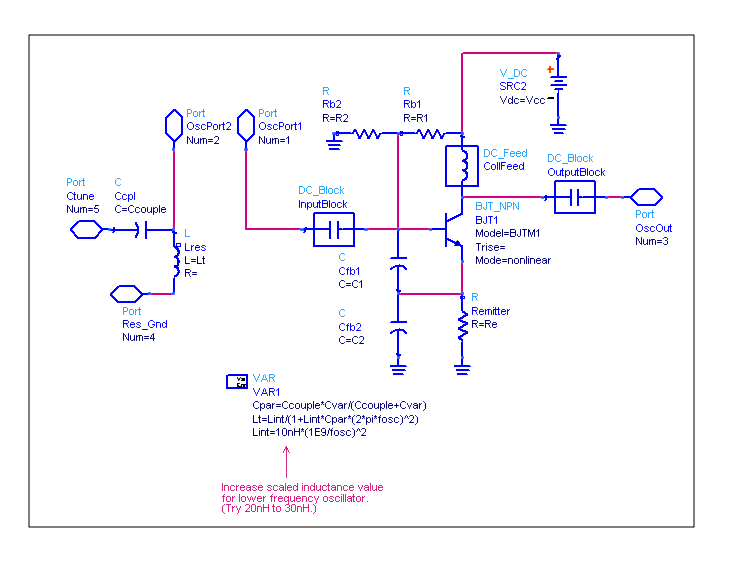
The Oscillator Design Guide is integrated into Agilent EEsof's Advanced Design System environment, functioning as a smart library and interactive handbook for creating effective designs. It enables quick oscillator design, interactive characterization of components, and provides in-depth insights into their operation. The guide is easily modifiable to user-defined configurations. The initial release of this Design Guide emphasizes RF printed circuit boards and microwave oscillations. This manual assumes familiarity with basic ADS program operations. For further information, refer to the Schematic Capture and Layout manual. The Oscillator Design Guide includes templates for use in the ADS software environment, featuring design examples such as generic Colpitts, Clapp, modified Colpitts, modified Clapp, and Hartley oscillators, along with a library of components and characterization tools. Push-button nonlinear measurements are recommended for both expert and novice users creating large-signal designs. For experts, these measurements provide an overview of tool capabilities, while novice users gain a working oscillator and simulations of typical characteristics of nonlinear designs. The complete set of available large-signal measurements in the Generic Oscillator example is detailed in Table 2-1, with subsets appearing in other examples. Table 2-1 also describes available push-button large-signal measurements, along with associated filenames for schematics and data displays. The linear and nonlinear design tools facilitate the design of oscillators from scratch and provide insights into existing oscillators. The full selection of tools is available in the Generic Oscillator example, while other examples utilize only those tools pertinent to their specific cases. The guide includes Kurokawa Plots, their justification (describing function method), and definitions of large signal S-parameters, with tools for easy selection of Kurokawa Plots (presented in KurPlot1). The components and component characterization libraries contain a small custom library of resonators and devices, aiding in the modification of existing oscillators or the assembly of new ones. These include device DC and S-parameter characteristics, as well as resonator and filter S-parameter and impedance/admittance characteristics. Tables 2-3 through 2-5 provide schematic filenames and brief descriptions for each component, while Table 2-6 offers schematic filenames and brief descriptions for each component characterization tool. A simple amplifier with capacitive feedback is utilized in frequency pull and push simulations, applicable above 2GHz (for lower frequencies, refer to earlier sections). Custom amplifiers and matching circuits are encouraged for replacement. The cClappCore.dsn oscillator operates from 0.5 to 15GHz using existing component values in the Clapp oscillator sub-circuit. Resonator tank components Ct and Lt are automatically calculated with approximations referenced to 1GHz and displayed on some display pages. The Ground or Series Resonator port connects directly to ground or through a series resonator. The Variable Capacitance Tuning Port is used for VCO design by coupling a varactor diode across the tank capacitor Ct, with coupling achieved via capacitor Ccpl. Larger values of Ccpl yield tighter coupling and a wider tuning range for a given amount of tuning capacitance variation. The OscPort1 and OscPort2 ports can be connected directly together or through a series resonator, allowing for the connection of the OscPort test probe between these two ports for harmonic balance oscillator simulations. The Output Port serves as the oscillator signal output. The variable Ctune sets the oscillator to the desired oscillation frequency when the capacitance across the Variable Capacitance Tuning Port matches the Ctune set value. Figure 2-2 illustrates the Clapp Oscillator subcircuit. Capacitors C1 and C2 can be increased for lower frequency oscillator circuits, and the resonator frequency offset (currently 390E6) can be adjusted to recenter the oscillator frequency. Figure 2-3 depicts the cHartleyCore.dsn oscillator core schematic symbol, which operates from 1 to 1000MHz using existing component values in the Hartley oscillator sub-circuit. The resonator tank component Ct is scaled from 500MHz with an approximation and displayed on some display pages. The Ground or Series Resonator can connect directly to ground or through a series resonator. The Variable Capacitance Tuning Port facilitates VCO design by coupling a varactor diode across the tank capacitor Ct, with coupling accomplished via capacitor Ccpl. Larger values of Ccpl yield tighter coupling and a wider tuning range for a given amount of tuning capacitance variation. The OscPort1 and OscPort2 ports can be connected directly or through a series resonator, and for harmonic balance oscillator simulations, the OscPort test probe should be connected between these two ports. The Output Port is utilized for oscillator signal output. The variable Ctune sets the oscillator at the desired oscillation frequency when the capacitance across the Variable Capacitance Tuning Port equals the Ctune set value. Figure 2-4 shows the Hartley Oscillator subcircuit. Inductors L1 and L2 can be increased for lower frequency oscillator circuits, and the resonator capacitor Ct reference value (currently 21.3pF) can be adjusted to recenter the oscillator frequency. Figure 2-5 illustrates the cModifiedClappCore.dsn oscillator core schematic symbol. The cModifiedClappCore.dsn oscillator operates from 0.7 to 7.2GHz using existing component values in the Modified Clapp oscillator sub-circuit. Resonator tank components Ct and Lt are automatically calculated with approximations referenced to 1GHz and displayed on some display pages. The Ground or Series Resonator port can be connected directly to ground or through a series resonator. The Variable Capacitance Tuning Port is used for VCO design by coupling a varactor diode across the tank capacitor Ct, with coupling achieved via capacitor Ccpl. Larger values of Ccpl yield tighter coupling and a wider tuning range for a given amount of tuning capacitance variation. The OscPort1 and OscPort2 ports can be connected directly together or through a series resonator, allowing for the connection of the OscPort test probe between these two ports for harmonic balance oscillator simulations. The Output Port serves as the oscillator signal output. The variable Ctune sets the oscillator at the desired oscillation frequency when the capacitance across the Variable Capacitance Tuning Port is equal to the Ctune set value.
The Oscillator Design Guide is a comprehensive resource for engineers engaged in oscillator design, particularly in the RF and microwave domains. It provides essential templates and tools to facilitate the design process, allowing users to create and modify oscillator circuits efficiently. The inclusion of various oscillator types—Colpitts, Clapp, Hartley, and their modified versions—ensures that users can select the most suitable configuration for their specific application requirements. The design examples come with detailed measurements and characterization tools that enable users to understand the performance of their designs in both linear and nonlinear domains.
The guide emphasizes the importance of component characterization, providing a library of resonators, devices, and their respective characteristics, which are crucial for accurate design and simulation. The push-button nonlinear measurements serve as a practical starting point for users, allowing them to quickly generate working designs and explore the capabilities of the ADS environment. This flexibility is particularly advantageous for novice users who may require additional guidance.
The oscillator circuits detailed in the guide, such as the Clapp and Hartley oscillators, are designed to operate over a broad frequency range, accommodating various application needs. The use of variable capacitance tuning ports and coupling capacitors enhances tuning capabilities, making these oscillators suitable for voltage-controlled oscillator (VCO) applications. The detailed schematic representations and the ability to adjust component values provide users with the necessary tools to optimize their designs for desired performance specifications.
Overall, the Oscillator Design Guide serves as a vital tool for electronic engineers, streamlining the design process and enhancing understanding of oscillator behavior in complex RF and microwave applications.The Oscillator DesignGuide is integrated into Agilent EEsof`s Advanced Design System environment, working as a smart library and interactive handbook for the creation of useful designs. It allows you to quickly design oscillators, interactively characterize their components, and receive in-depth insight into their operation.
It is easily modifiabl e to user-defined configurations. The first release of this DesignGuide focuses on RF printed circuit boards and microwave oscillations. NoteThis manual assumes that you are familiar with all of the basic ADS program operations. For additional information, refer to the Schematic Capture and Layout manual. The Oscillator DesignGuide contains templates that can be used in the ADS software environment. It consists of generic colpitts, clapp, modified colpitts, modified clapp, and hartley oscillator design examples, and a library of components and component characterization tools.
The push-button nonlinear measurements are recommended as a starting point for both expert and novice users creating large-signal designs. For the expert, these measurements provide an overview of tool capabilities. For the novice user, they provide a working oscillator together with simulations of its typical characteristics of nonlinear designs.
The full set of available large-signal measurements in the Generic Oscillator example are described in Table 2-1. Subsets of these measurements appear in other examples. Refer to the section Additional Examples. Table 2-1 provides descriptions of the available push-button large-signal measurements, as well as the associated filenames for schematics and data displays.
The linear and nonlinear design tools are intended to facilitate you in designing an oscillator from scratch and in gaining insight into an existing oscillator. The full selection of tools is contained in the Generic Oscillator example. Other examples use only those tools that are useful in their particular case. Image of Kurokawa Plots, their justification (describing function method), and definition of large signal S-parameters.
Tools for easy selection of Kurokawa Plots (presented in KurPlot1) The items in the Components and Component Characterization libraries contain a small custom library of resonators and devices, which can help in either modifying an existing oscillator or assembling a new one. They include device DC and S-parameter characteristics, as well as resonator and filter S-parameter and impedance/admittance characteristics.
Table 2-3 through Table 2-5 provide schematic filenames and brief descriptions for each component. Table 2-6 provides schematic filenames and brief descriptions for each component characterization tool. A simple amplifier with capacitive feedback used in frequency pull and push simulations, used above 2GHz (for lower frequencies, see below).
You are encouraged to replace it by your own amplifier and matching circuit. The cClappCore. dsn oscillator operates from 0. 5 to 15GHz using the existing component values in the Clapp oscillator sub-circuit. Resonator tank components Ct and Lt are automatically calculated with approximations referenced to 1GHz and displayed on some display pages. The Ground or Series Resonator port is either connected directly to ground or connected to ground through a series resonator.
The Variable Capacitance Tuning Port is used for VCO design by coupling a varactor diode across the tank capacitor Ct. Coupling is accomplished by capacitor Ccpl. Larger values of Ccpl yield tighter coupling and wider tuning range for a given amount of tuning capacitance variation.
The OscPort1 and OscPort2 ports are either connected directly together or connected through a series resonator. You can connect the OscPort test probe between these two ports for harmonic balance oscillator simulations.
The Output Port is used for oscillator signal output. The variable Ctune sets the oscillator at the desired oscillation frequency when the capacitance across the Variable Capacitance Tuning Port is equal to the Ctune set value. Figure 2-2 is an example of the Clapp Oscillator subcircuit. Increase capacitors C1 and C2 for lower frequency oscillator circuits. Adjust resonator frequency offset (currently 390E6) to recenter oscillator frequency. Figure 2-3 shows the cHartleyCore. dsn oscillator core schematic symbol. This oscillator operates from 1 to 1000MHz using the existing component values in the Hartley oscillator sub-circuit.
The resonator tank component Ct is scaled from 500MHz with an approximation and displayed on some display pages. You can connect the Ground or Series Resonator to the port directly to ground, or it can be connected to ground through a series resonator.
The Variable Capacitance Tuning Port is used for VCO design by coupling a varactor diode across the tank capacitor Ct. Coupling is accomplished by capacitor Ccpl. Larger values of Ccpl yield tighter coupling and wider tuning range for a given amount of tuning capacitance variation.
The OscPort1 and OscPort2 ports are either connected directly together or connected through a series resonator. For harmonic balance oscillator simulations, connect the OscPort test probe between these two ports. The Output Port is used for oscillator signal output. The variable Ctune sets the oscillator at the desired oscillation frequency when the capacitance across the Variable Capacitance Tuning Port is equal to the Ctune set value.
Figure 2-4 shows the Hartley Oscillator subcircuit. Increase inductors L1 and L2 for lower frequency oscillator circuits. Adjust resonator capacitor Ct reference value (currently 21. 3pF) to recenter oscillator frequency. Figure 2-5 shows the cModifiedClappCore. dsn oscillator core schematic symbol. The cModifiedClappCore. dsn oscillator operates from 0. 7 to 7. 2GHz using the existing component values in the Modified Clapp oscillator sub-circuit. Resonator tank components Ct and Lt are automatically calculated with approximations referenced to 1GHz and displayed on some display pages. The Ground or Series Resonator port can be connected directly to ground or connected to ground through a series resonator.
The Variable Capacitance Tuning Port is used for VCO design by coupling a varactor diode across the tank capacitor Ct. Coupling is accomplished by capacitor Ccpl. Larger values of Ccpl yield tighter coupling and wider tuning range for a given amount of tuning capacitance variation.
The OscPort1 and OscPort2 ports are either connected directly together or connected through a series resonator. You can connect the OscPort test probe between these two ports for harmonic balance oscillator simulations.
The Output Port is used for oscillator signal output. Variable Ctune sets the oscillator at the desired oscillation frequency when the capacitance across the Variable Ca as well. 🔗 External reference
The Oscillator Design Guide is a comprehensive resource for engineers engaged in oscillator design, particularly in the RF and microwave domains. It provides essential templates and tools to facilitate the design process, allowing users to create and modify oscillator circuits efficiently. The inclusion of various oscillator types—Colpitts, Clapp, Hartley, and their modified versions—ensures that users can select the most suitable configuration for their specific application requirements. The design examples come with detailed measurements and characterization tools that enable users to understand the performance of their designs in both linear and nonlinear domains.
The guide emphasizes the importance of component characterization, providing a library of resonators, devices, and their respective characteristics, which are crucial for accurate design and simulation. The push-button nonlinear measurements serve as a practical starting point for users, allowing them to quickly generate working designs and explore the capabilities of the ADS environment. This flexibility is particularly advantageous for novice users who may require additional guidance.
The oscillator circuits detailed in the guide, such as the Clapp and Hartley oscillators, are designed to operate over a broad frequency range, accommodating various application needs. The use of variable capacitance tuning ports and coupling capacitors enhances tuning capabilities, making these oscillators suitable for voltage-controlled oscillator (VCO) applications. The detailed schematic representations and the ability to adjust component values provide users with the necessary tools to optimize their designs for desired performance specifications.
Overall, the Oscillator Design Guide serves as a vital tool for electronic engineers, streamlining the design process and enhancing understanding of oscillator behavior in complex RF and microwave applications.The Oscillator DesignGuide is integrated into Agilent EEsof`s Advanced Design System environment, working as a smart library and interactive handbook for the creation of useful designs. It allows you to quickly design oscillators, interactively characterize their components, and receive in-depth insight into their operation.
It is easily modifiabl e to user-defined configurations. The first release of this DesignGuide focuses on RF printed circuit boards and microwave oscillations. NoteThis manual assumes that you are familiar with all of the basic ADS program operations. For additional information, refer to the Schematic Capture and Layout manual. The Oscillator DesignGuide contains templates that can be used in the ADS software environment. It consists of generic colpitts, clapp, modified colpitts, modified clapp, and hartley oscillator design examples, and a library of components and component characterization tools.
The push-button nonlinear measurements are recommended as a starting point for both expert and novice users creating large-signal designs. For the expert, these measurements provide an overview of tool capabilities. For the novice user, they provide a working oscillator together with simulations of its typical characteristics of nonlinear designs.
The full set of available large-signal measurements in the Generic Oscillator example are described in Table 2-1. Subsets of these measurements appear in other examples. Refer to the section Additional Examples. Table 2-1 provides descriptions of the available push-button large-signal measurements, as well as the associated filenames for schematics and data displays.
The linear and nonlinear design tools are intended to facilitate you in designing an oscillator from scratch and in gaining insight into an existing oscillator. The full selection of tools is contained in the Generic Oscillator example. Other examples use only those tools that are useful in their particular case. Image of Kurokawa Plots, their justification (describing function method), and definition of large signal S-parameters.
Tools for easy selection of Kurokawa Plots (presented in KurPlot1) The items in the Components and Component Characterization libraries contain a small custom library of resonators and devices, which can help in either modifying an existing oscillator or assembling a new one. They include device DC and S-parameter characteristics, as well as resonator and filter S-parameter and impedance/admittance characteristics.
Table 2-3 through Table 2-5 provide schematic filenames and brief descriptions for each component. Table 2-6 provides schematic filenames and brief descriptions for each component characterization tool. A simple amplifier with capacitive feedback used in frequency pull and push simulations, used above 2GHz (for lower frequencies, see below).
You are encouraged to replace it by your own amplifier and matching circuit. The cClappCore. dsn oscillator operates from 0. 5 to 15GHz using the existing component values in the Clapp oscillator sub-circuit. Resonator tank components Ct and Lt are automatically calculated with approximations referenced to 1GHz and displayed on some display pages. The Ground or Series Resonator port is either connected directly to ground or connected to ground through a series resonator.
The Variable Capacitance Tuning Port is used for VCO design by coupling a varactor diode across the tank capacitor Ct. Coupling is accomplished by capacitor Ccpl. Larger values of Ccpl yield tighter coupling and wider tuning range for a given amount of tuning capacitance variation.
The OscPort1 and OscPort2 ports are either connected directly together or connected through a series resonator. You can connect the OscPort test probe between these two ports for harmonic balance oscillator simulations.
The Output Port is used for oscillator signal output. The variable Ctune sets the oscillator at the desired oscillation frequency when the capacitance across the Variable Capacitance Tuning Port is equal to the Ctune set value. Figure 2-2 is an example of the Clapp Oscillator subcircuit. Increase capacitors C1 and C2 for lower frequency oscillator circuits. Adjust resonator frequency offset (currently 390E6) to recenter oscillator frequency. Figure 2-3 shows the cHartleyCore. dsn oscillator core schematic symbol. This oscillator operates from 1 to 1000MHz using the existing component values in the Hartley oscillator sub-circuit.
The resonator tank component Ct is scaled from 500MHz with an approximation and displayed on some display pages. You can connect the Ground or Series Resonator to the port directly to ground, or it can be connected to ground through a series resonator.
The Variable Capacitance Tuning Port is used for VCO design by coupling a varactor diode across the tank capacitor Ct. Coupling is accomplished by capacitor Ccpl. Larger values of Ccpl yield tighter coupling and wider tuning range for a given amount of tuning capacitance variation.
The OscPort1 and OscPort2 ports are either connected directly together or connected through a series resonator. For harmonic balance oscillator simulations, connect the OscPort test probe between these two ports. The Output Port is used for oscillator signal output. The variable Ctune sets the oscillator at the desired oscillation frequency when the capacitance across the Variable Capacitance Tuning Port is equal to the Ctune set value.
Figure 2-4 shows the Hartley Oscillator subcircuit. Increase inductors L1 and L2 for lower frequency oscillator circuits. Adjust resonator capacitor Ct reference value (currently 21. 3pF) to recenter oscillator frequency. Figure 2-5 shows the cModifiedClappCore. dsn oscillator core schematic symbol. The cModifiedClappCore. dsn oscillator operates from 0. 7 to 7. 2GHz using the existing component values in the Modified Clapp oscillator sub-circuit. Resonator tank components Ct and Lt are automatically calculated with approximations referenced to 1GHz and displayed on some display pages. The Ground or Series Resonator port can be connected directly to ground or connected to ground through a series resonator.
The Variable Capacitance Tuning Port is used for VCO design by coupling a varactor diode across the tank capacitor Ct. Coupling is accomplished by capacitor Ccpl. Larger values of Ccpl yield tighter coupling and wider tuning range for a given amount of tuning capacitance variation.
The OscPort1 and OscPort2 ports are either connected directly together or connected through a series resonator. You can connect the OscPort test probe between these two ports for harmonic balance oscillator simulations.
The Output Port is used for oscillator signal output. Variable Ctune sets the oscillator at the desired oscillation frequency when the capacitance across the Variable Ca as well. 🔗 External reference

